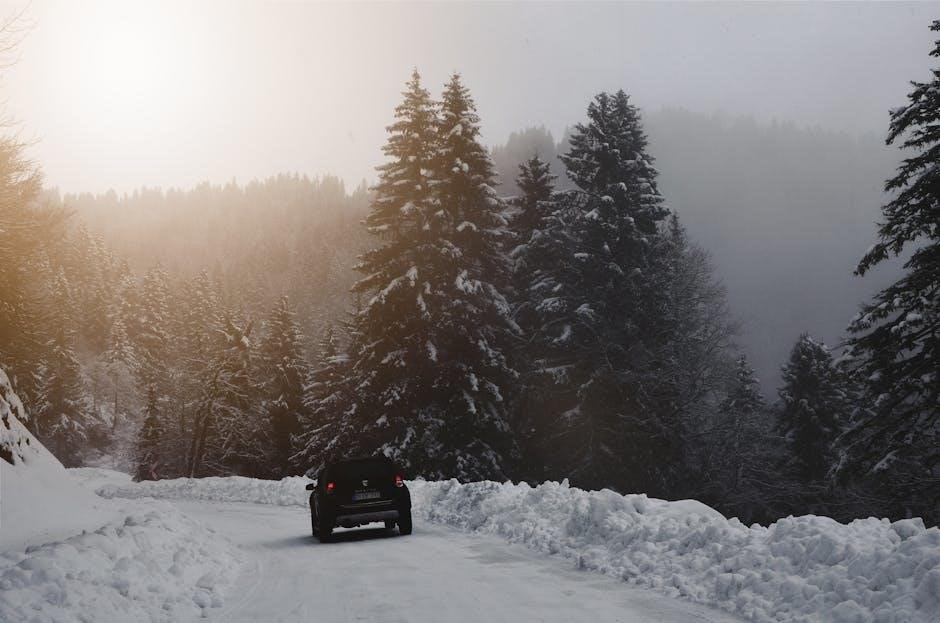Remote starters offer convenience, especially in cold climates, but their installation on manual cars requires careful consideration․ Special systems are needed to ensure safety and proper functionality․ While they can be installed, specific precautions must be taken to prevent unintended movement; The process involves additional components and procedures compared to automatic vehicles, making it more complex․ However, with the right setup, remote starters can enhance comfort and accessibility for manual car owners, though challenges like higher costs and technical requirements exist․
What is a Remote Starter?
A remote starter is an electronic system that allows a car to be started from a distance, typically using a key fob or smartphone app․ It provides convenience, enabling drivers to precondition their vehicle’s temperature without physical proximity․ While commonly used in automatic vehicles, remote starters can also be adapted for manual cars with specific modifications․ These systems often include features like engine start/stop, door lock/unlock, and trunk release․ For manual vehicles, additional safety measures are required to prevent unintended movement, such as ensuring the car is in neutral and the emergency brake is engaged․ Compatibility varies, but specialized systems are available for manual cars, ensuring functionality and safety․
Why Remote Starters are Popular for Manual Cars
Remote starters are gaining popularity among manual car owners due to the convenience and comfort they provide․ They allow drivers to preheat or cool their vehicle from a distance, eliminating the need to physically start the car․ This feature is especially appealing in extreme weather conditions, ensuring a comfortable cabin temperature upon entry․ Additionally, remote starters add a modern, high-tech feature to older or simpler manual vehicles; While manual cars are often chosen for their driving experience, remote starters enhance usability without compromising the unique appeal of a manual transmission․ The ability to start the car remotely is a significant convenience, making it a sought-after accessory for manual car enthusiasts․
Safety Considerations for Manual Cars
Remote starters for manual cars require careful safety measures to prevent unintended movement․ Always ensure the vehicle is in neutral and the emergency brake is engaged before starting remotely․
The Importance of Neutral Gear and Emergency Brake
For manual cars, engaging the neutral gear and emergency brake is critical when using a remote starter․ This ensures the vehicle cannot move unexpectedly, preventing accidents or damage․ Failing to secure the car properly can lead to unintended movement, posing safety risks․ The neutral gear disengages the transmission, while the emergency brake holds the vehicle stationary․ These steps are non-negotiable for safe remote starting․ Always double-check these settings before activating the remote start to avoid potential hazards․ Proper use of neutral and the emergency brake ensures the system functions safely and reliably, making remote starters a practical option for manual car owners․
Preventing Unintended Movement
Preventing unintended movement is essential for safely using a remote starter on a manual car․ Specialized systems, such as clutch bypass modules, are designed to ensure the vehicle doesn’t move when started remotely․ These modules simulate the clutch being pressed, preventing the car from engaging the gears unintentionally․ Additionally, modern remote starters often include sensors to detect if the car is in neutral and if the emergency brake is engaged․ If these conditions aren’t met, the system will not activate․ This layered approach ensures the vehicle remains stationary during remote starting, eliminating the risk of accidental movement and enhancing overall safety for manual transmission vehicles․

Remote Starter Compatibility with Manual Transmissions
Remote starters are compatible with manual cars but require specialized systems to ensure safe operation․ These systems often include clutch bypass modules and additional safety features designed specifically for manual transmissions․
Special Requirements for Manual Cars
Manual cars require specific modifications for remote starters to function safely and effectively․ The vehicle must be in neutral gear with the emergency brake engaged to prevent unintended movement․ Specialized systems, such as clutch bypass modules, are necessary to simulate the clutch engagement process, ensuring the car starts without manual intervention․ Additionally, these systems often require a “reservation mode” to arm the vehicle, which involves leaving it in neutral and activating the brake․ Standard remote starters are not compatible with manual transmissions, so specialized kits designed for manual cars must be used to address these unique challenges and ensure safe operation․

Features to Look for in a Remote Starter System
When selecting a remote starter system for a manual car, look for features that address safety and functionality․ Ensure the system includes a clutch bypass module to simulate clutch engagement, allowing the car to start without manual intervention․ Reservation mode is essential, requiring the car to be in neutral with the emergency brake engaged before remote starting․ Valet mode adds security by preventing unauthorized remote starts․ Compatibility with manual transmissions is crucial, as standard systems are designed for automatics․ Rolling code encryption enhances security, while a multi-step arming process ensures the vehicle is in a safe state․ A reliable range on the remote and clear user instructions are also important for seamless operation․

Installation Process
Installing a remote starter on a manual car requires a clutch bypass module to simulate clutch engagement․ Ensure the vehicle is in neutral with the emergency brake on; Professional installation is recommended due to complexity and safety concerns․ Additional wiring and programming are necessary for proper functionality․ Compatibility with manual transmissions must be verified․ Follow manufacturer instructions carefully to avoid errors and ensure reliability․ Proper setup ensures safe operation and prevents unintended movement․ Regular testing post-installation is crucial to confirm everything works as intended․ A well-installed system enhances convenience while maintaining safety standards․ Always consult a certified technician for optimal results․
Hardware and Software Requirements
Installing a remote starter on a manual car requires specific hardware, including a clutch bypass module to simulate clutch engagement․ This module is essential for remote starting, as it mimics the driver pressing the clutch pedal․ The system must also integrate with the vehicle’s electrical and ignition systems․ Software requirements include specialized programming to handle manual transmission logic, ensuring the car is in neutral and the emergency brake is engaged before starting․ Compatibility with the vehicle’s computer is crucial for proper functionality․ Additional components like sensors and wiring may be needed to ensure safety and reliability․ Always use a system designed for manual transmissions to avoid malfunctions․ Professional installation is highly recommended to meet all technical specifications and safety standards․
Clutch Bypass Module and Its Role
A clutch bypass module is a critical component for remote starters in manual cars․ It simulates the action of pressing the clutch pedal, enabling the engine to start without manual intervention․ This module ensures the car is in neutral and the emergency brake is engaged before starting, preventing unintended movement․ It integrates with the vehicle’s ignition system, allowing the remote starter to function safely and effectively․ The module acts as a bridge between the remote starter and the car’s clutch mechanism, ensuring proper engagement and disengagement․ Without it, remote starting would not be possible on manual cars, as the system cannot otherwise mimic the driver’s actions․ It is essential for both functionality and safety in manual transmission vehicles equipped with a remote starter․
Programming the Remote Starter System
Programming a remote starter system for a manual car involves configuring the device to recognize and interact with the vehicle’s specific features․ This includes setting up the system to ensure the car is in neutral and the emergency brake is engaged before starting․ The process typically requires entering a reservation mode, which allows the system to verify safety conditions․ Once programmed, the remote starter can activate the engine while maintaining safety protocols․ Proper programming ensures seamless communication between the remote starter and the car’s ignition system․ It is crucial to follow the manufacturer’s instructions or consult a professional to avoid errors and ensure reliable operation․ Correct programming is essential for both functionality and safety in manual transmission vehicles․

Using a Remote Starter on a Manual Car
Engage safety protocols by arming the system, ensuring the car is in neutral with the emergency brake on․ Activate reservation mode to enable remote start functionality securely․
Arming and Disarming the System
Arming the remote starter system on a manual car requires specific steps to ensure safety․ First, the vehicle must be in neutral gear with the emergency brake engaged․ Once these conditions are met, the system can be armed using the remote control․ The process typically involves pressing a button on the remote to activate reservation mode, which prepares the car for remote starting․ Disarming occurs automatically when the car is started manually or by pressing the disarm button on the remote․ Additional safety features, such as valet mode, can prevent unauthorized use․ Always follow the manufacturer’s instructions to avoid unintended movement or system malfunctions․
Reservation Mode and Remote Start Activation
Reservation mode is a critical step for remote starting a manual car, ensuring safety and proper activation․ To engage reservation mode, the vehicle must be in neutral gear with the emergency brake applied․ Once these conditions are met, pressing the remote start button activates reservation mode, preparing the car for remote ignition․ The system verifies the car’s state before starting the engine, preventing unintended movement․ This mode serves as a failsafe, ensuring the car is in a safe condition to start remotely․ Activation involves a specific button sequence, typically pressing the remote start button twice, to initiate the process․ Reservation mode enhances convenience while maintaining safety standards for manual car owners, allowing them to preheat or cool their car without physical access․
Benefits and Drawbacks
Remote starters offer convenience and comfort for manual car owners but come with higher costs and complexity․ They provide ease of use but require careful setup and maintenance․
Advantages of Remote Start for Manual Cars
Remote starters for manual cars offer enhanced convenience, allowing drivers to start their vehicles from a distance․ This feature is particularly beneficial in cold climates, as it enables preheating the engine and warming up the interior․ Additionally, remote starters can improve accessibility, especially for drivers with mobility challenges․ They also provide peace of mind by ensuring the vehicle is ready to go without physical effort․ Modern systems designed for manual transmissions include safety features to prevent unintended movement, making them a practical solution for car owners who value comfort and ease of use․ These advantages make remote starters a worthwhile investment for many manual car enthusiasts․
Potential Challenges and Limitations
Installing a remote starter on a manual car presents unique challenges․ The system requires additional components, such as a clutch bypass module, to ensure safe operation․ Compatibility issues may arise, as not all manual vehicles support remote start functionality․ The installation process is often more complex and costly compared to automatic cars․ Drivers must also ensure the vehicle is in neutral and the emergency brake is engaged, which can be inconvenient; Furthermore, improper installation or failure to follow safety protocols can lead to unintended movement or damage․ These limitations make remote starters less straightforward for manual cars, requiring careful consideration and professional installation to avoid potential risks․
Remote starters can be installed on manual cars with proper safety measures and specialized systems․ Professional installation is recommended to ensure functionality and avoid potential risks․
Final Thoughts on Remote Starters for Manual Cars
Remote starters for manual cars are a convenient solution but require careful consideration․ While they offer benefits like preheating and enhanced comfort, the unique challenges of manual transmissions demand specialized systems․ Ensuring safety and proper functionality is crucial, often requiring professional installation․ Owners must weigh the convenience against potential costs and technical complexities․ For those willing to invest, a well-installed remote starter can significantly improve their driving experience․ However, for others, the additional effort and expense may not justify the benefits․ Ultimately, manual car owners should evaluate their needs and budget before deciding to install a remote starter system․
Recommendations for Car Owners
For manual car owners considering a remote starter, it’s essential to choose a system specifically designed for manual transmissions․ Professional installation is highly recommended to ensure safety and proper functionality․ Always opt for a system with features like reservation mode and clutch bypass to address unique manual transmission challenges․ Prioritize systems with safety mechanisms, such as emergency brake and neutral gear detection, to prevent unintended movement․ Additionally, look for systems with valet mode to enhance security․ Owners should carefully follow manufacturer guidelines and test the system thoroughly after installation․ Investing in a high-quality remote starter designed for manual cars ensures reliability and peace of mind, making the feature both convenient and safe․